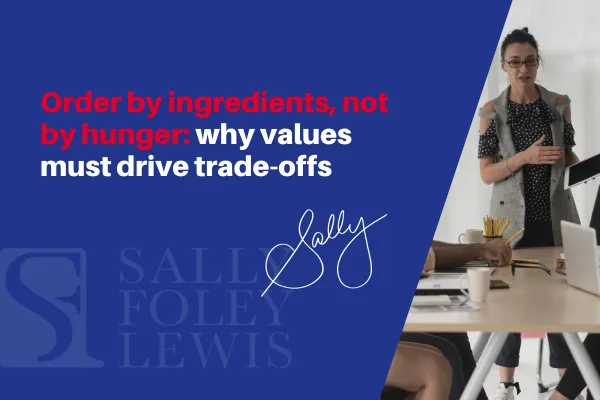
Order by ingredients, not by hunger: why values must drive trade-offs
Southwest Airlines grew by saying no. No meals, no assigned seats, no interline baggage transfers, no premium cabins. Those choices protected what mattered most: low cost and reliable, frequent service. That is values in action. It is also strategy in action, because strategy depends on trade-offs. When everything looks important, values tell you what to do now, what to do next, and what not to do at all.
Middle managers sit where competing priorities collide. A senior stakeholder wants speed. Risk wants guardrails. Customers want clarity. Your calendar wants a rest. In that noise, values are your non-negotiable filter. They let you say a confident yes to the right work and a respectful no to the rest.
Fit Before Force

A sustainable strategy is not just choosing what to do, it is choosing what not to do. That is why the filter starts with values. If a piece of work misses values alignment, it is either redesigned or deprioritised, even when it looks urgent or politically attractive. Values give you permission to hold the line.
There is strong psychology behind this discipline. Schwartz’s theory of Basic Values shows that values are the criteria we use to evaluate actions, and that universal value tensions make trade-offs inevitable. (1) Clarity about values reduces friction in decisions. When goals align with personal values, people pursue them more consistently and achieve more, which also lifts wellbeing. This is the essence of self-concordance: value-fit fuels persistence and performance. (2) At work, value congruence is linked with higher job satisfaction and engagement, strengthening execution once priorities are set.

A practical trap to avoid is mistaking urgency for importance. Tools like the Eisenhower Matrix help teams keep reactive work from crowding out values-aligned priorities. (3) Combine that urgency-importance lens with your values filter and you get both speed and sanity.
The burger makes it memorable. Order by ingredients, not by hunger:

Here is how to apply this:
Name the protein.Clarify 3 to 5 organisational values and two personal leadership values. Write one sentence for each that defines what you will not do because of it.
Translate values into rules.For each value, create a simple test. For example, “If it reduces customer trust, we do not ship it.”
Map the work.Place every live initiative in the Venn. Anything outside Values is paused and re-scoped first.
Run the 2×2.Rate Values Alignment and Strategic Impact high or low. Decide by quadrant, not by queue order.
Communicate the trade-off.State the value driving the choice, the impact you are prioritising, and what you are stopping or delaying.
Cadence and calibration.Review weekly as a team and monthly with your manager to protect alignment up and down.
If you need a second real-world proof point, look at IKEA. Customers pick up and deliver their own flat-packs. IKEA will even sell you a roof rack. That is a values-driven trade-off in service of price and speed. It is deliberate and it works (4)
What if you do the opposite?
You chase urgency, quality drops, and burnout rises. Priorities swing with the loudest stakeholder, trust erodes, and your team escalates everything because decisions feel arbitrary. A values misfit undermines satisfaction and performance.
Values do not slow you down. They speed you up by removing debate about the wrong work. That is why Michael E. Porter’s (Harvard Business School Professor), famous warning about confusing operational excellence with strategy still matters. Strategy is choice, and choice is anchored in values. So, the next time your inbox screams, “Everything is urgent,” take a breath and order by ingredients. Get the protein right first. Your future self, your stakeholders, and your team will thank you for the better burger.